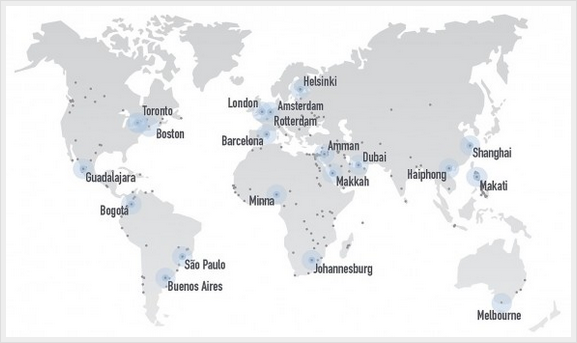
Photo: The-value-of-sustainability-reporting-by-cities
The value of sustainability reporting by cities
01 December 2014
by Richard Forster
Jonathan Ballantine looks at why more mayors are committing to sustainability reports and highlights the benefits for cities of the launch of the World Council on City Data
The direction that cities take today will be a determining factor for sustainability and growth across the world for decades to come. Managed correctly, sustainability initiatives can reduce economic, environmental and social risks by delineating solutions to address urban challenges. But as with the mantra espoused by former New York Mayor Michael Bloomberg – If you can’t measure it, you can’t manage it – cities need to report on their sustainability, otherwise how can we tell if their initiatives are making a difference?
Global companies are already reporting and disclosing their commitments to sustainability. Although there are differences between the types of indicators being measured and the degree of scope, there is a shared common purpose for increasing transparency and building trust amongst external stakeholders. Leaders of these corporations understand how engaging in dialogue with customers, suppliers, employees and investors is critical for creating a vibrant company that is capable of competing in today’s global economy.
Around 5,000 reporting companies are using the guidelines set by the Global Reporting Initiative (GRI) but the number of public sector organisations listed on the GRI database is only 2 percent.
“It is in every city’s interest to have organisations do sustainability reporting and work on reducing their impacts so that less of the city’s resources have to go towards accounting for the harm done,” says Teresa Fogelberg, Deputy Chief Executive of the GRI. “Cities should report on their own impacts as a way of encouraging businesses to do so as well.”
The GRI has now issued specific guidelines for the public sector and cities have begun to take up the baton on sustainability reporting.
“We made the strategic choice to begin by focusing on the private sector, and then in 2005 we issued guidance for public agencies,” says Fogelberg.
Since then a number of municipalities have issued GRI reports including Amsterdam, Chicago, Dublin, Rio de Janeiro and Warsaw.
“When the city of Amsterdam issued their sustainability report, they pulled together data that was previously hidden in unconnected silos where, for example, carbon emission data was being reported only to the climate change audience, so the reporting process allowed Amsterdam to create a holistic strategy,” adds Fogelberg.
While the Global Reporting Initiative has provided the impetus for cities to follow corporates into sustainability reporting, it is important to highlight the difference between the state of the environment reports produced by public sector organisations and the corporate social responsibility reports produced by businesses. The former focus on the environmental and social health of a city or municipality and changes in that health over time, whereas the latter look at the collective impact of an organisation’s business activities in order to minimise any negative impact on the environment.
Why report?
A commitment to sustainability reporting is a vital step towards creating vibrant cities. Reporting can open up dialogue with stakeholders, and demonstrates leadership and accountability. The availability of sustainability information can be used to support internal decision- making processes, leading to efficiency improvements and cost reductions in the delivery of city services.
“I think it is really important for cities to report as it demonstrates that they take sustainability issues seriously and encourages citizens and local businesses to do the same,” says Gwendolen B. White from Indiana University, who was faculty advisor for the City of Bloomington Sustainability Report.
This is a view shared by Mark Bennett, Green Business Officer in Dublin City Council, which recently launched its fourth annual sustainability report.

“There are three key purposes to our sustainability report: firstly to give the people of Dublin the information they need to understand the opportunities and challenges we face so that they can get involved in helping us to address them; secondly, it outlines our sustainability vision; and thirdly it provides us with the necessary data for evidence-based decision making,” explains Bennett. “The reports have been downloaded thousands of times and have proved to be a useful tool for local and international stakeholders to stay informed of our sustainability progress.”
Professor Carol Adams of the Monash Sustainability Institute echoes this, emphasising that the report process will improve decision making at local government level.
“The real value of sustainability reporting is not the report itself, but rather the process of preparing the report– determining material issues, engaging stakeholders and collecting information and data not previously collected,” says Adams. “The process leads to better decision-making and the fact that information will be made public provides a strong incentive to improve performance.”
With the European Commission developing legislation that will oblige companies to annually disclose information regarding environment, social, and diversity matters, cities across the region may want to set the lead through open and transparent GRI reporting.
“Sustainability reporting by local governments is a valuable tool for more effective governance, and non- financial issues are important for local governments to be re-elected,” comments Pedro Ballesteros, International Relations Officer at the European Commission. “I do not believe in reporting for the sake of it, it must add something concrete. In the case of the Covenant of Mayors, non-financial reporting serves to make the case for local initiatives to tackle climate change while promoting local socio- economical dynamics.”
In 2013, the City of Warsaw released its first integrated sustainability report, the first by any organisation to adopt the latest standard from GRI.
“We are pleased to have taken this pragmatic step on behalf of our citizens and other stakeholders, and are glad that others can learn from watching the evolution of what we are doing,” says Leszek Drogosz, Warsaw’s Director of Infrastructure. “This year, we are absorbing feedback collected from a range of experts and stakeholders, including those who participated in open public forums.”

The report highlights Warsaw’s progress on a number of economic, social, and environmental impacts, and serves as a leading example of a local government utilising reporting guidelines. Professor Adam Sulkowski of the University of Massachusetts Dartmouth, who has implemented sustainability reporting at cities and with other organisations in the private and public sectors, led the team.
“For us and for all cities, there may be a two-fold, ongoing challenge: (1) to deliver not only user-friendly but actionable information for citizens and visitors, and (2) how to assure the process stays credible, constructive, apolitical, and sustained indefinitely, past the tenure of any single office-holder,” says Sulkowski.
Large cities are not the only ones to see value in sustainability reporting. In 2012, the City of Fall River (population: approximately 89,000) and the town of Dartmouth (population: approximately 34,000), both in the state of Massachusetts, became the first city and town, respectively, to adopt the GRI standard in the US.
Both were the result of collaboration between municipal officials and students from University of Massachusetts Dartmouth–a noteworthy approach, in that students gained skills that led to them being hired to undertake such reporting in both the public and private sectors.
“This is the kind of information people want to know when they consider moving to a town or city,” says David Cressman, Administrator in Dartmouth. “Most importantly, we have a consensus among town leadership that we will use this annual data reporting exercise to evaluate the success of what we are doing and to help guide future policy decisions.”
Under Mayor Emanuel’s leadership, Chicago has set specific goals across seven sustainability categories, and it was one of the first major cities to report under the GRI Sustainability Reporting Framework.
“Data transparency is a critical aspect for accelerating liveability, competitiveness and sustainability; from establishing a clear understanding of city focus, to providing data through our data portal for analysts and entrepreneurs, to engaging directly through hackathons and other events,” explains Karen Weigert, Chief Sustainability Officer for the City of Chicago.
Standards for reporting
Measuring, monitoring, and reporting on sustainability indicators is critical for cities to achieve long-term goals but to make this effective, uniform standards are necessary.
The Global Reporting Initiative sets guidelines for cities on how to report but not standards by which cities can benchmark themselves against one another. But in May 2014, the launch of the World Council on City Data backed by new International Standards marked watershed in city reporting.
“City indicators are an uneven science and until recently, cities across the globe would measure and benchmark performance on indicators according to different definitions and different methodologies,” says Patricia McCarney, President and CEO of the World Council on City Data (WCCD), who worked with the International Organisation for Standardisation on developing the new standard. “With ISO37120, we have authored the first ISO Standard so that cities can be ISO registered and report into a new Open Data Platform with standardised, third- party verified data.”
ISO 37120 Sustainable Development in Communities: Indicators for City Services and Quality of Life is the first ISO standard created for city metrics and provides a comprehensive set of indicators and a methodology that will enable any sized city in a developed or a developing economy to measure its social, economic and environmental performance in relation to other cities. The standardised set of 100 city indicators was developed, refined and agreed by cities globally and includes 46 core indicators, which cities must report on.
By creating an open data platform for cities globally, the World Council on City Data enables cities to sort themselves into peer groups globally, for example by region, by population size, by GDP per capita, by climate type, etc. The 20 founding cities of the World Council come from all continents and include Amman, Buenos Aires, Johannesburg, London, Makati and Shanghai. With ISO standardised data, for the first time cities have an apples-to-apples comparative framework for comparing the outcomes of sustainability initiatives.

Professor Sulkowski says that the GRI’s latest standard places more emphasis on describing stakeholder engagement and encourages narratives on how issues of concern to stakeholders are managed whereas the ISO standard specifies a comprehensive set of vital signs for municipalities. The 17 ISO themes encompass essential key indicators, including statistics related to public health and safety, education, air quality, waste management, connectivity, infrastructure, and economic activity.
“These might not all be data points that we think about every day and they do not completely overlap with GRI’s list of suggested disclosures–they are specific measures of what is essential to the sustained survival and thriving of a city, regardless of its location or comparative level of development,” says Sulkowski. “We’ve taken note of the new ISO standard and, like others, we’ll be very pleased to take it into account as we report and communicate with stakeholders moving forward.”
Getting started on reporting
Whichever standard one adopts, the reporting process helps make sustainability a concrete concept for city officials and citizens.
“To track progress to meeting goals, to benchmark against peers, to identify best practices and to build trust and communication with stakeholders, one needs to be mindful of at least five Cs when reporting, regardless of what standards are used, and regardless of the reporting entity: clarity, credibility, comprehensiveness yet conciseness and comparability,” says Professor Adam Sulkowski.
As with any major initiative, establishing a cross-functional team with strong executive-level sponsorship is critical to success. “When we first started out I suggested the idea to the highest level of management [in Dublin] and used their buy-in to draw representatives and subject matter experts from each of our departments to contribute to the content of the report, creating de facto ownership across departments,” says Bennett.
The formation of workshops, for both internal and external stakeholders, can help identify what really matters. These ‘materiality assessments’ require significant planning and resources in order to determine focus areas and priorities. For newcomers, it may be helpful to identify with cities of similar typology (ports/capitals) to understand what they have done. Once you’ve identified the areas of focus for the report, you can then develop a stakeholder plan that addresses who you are talking to and why.
“Organising stakeholder engagement may not be as daunting as it seems. In many cities, formal and informal stakeholders groups already exist, but they have not been consulted on sustainability reporting issues,” says White.
To help cities get started the GRI Public Sector Template can provide guidance on the metrics to be used in reporting. “As cities are faced with a wide range of topics on which they could report, it is crucial that they really hone in on the material aspects and boundaries, which encompass the topics that are most important for their stakeholders,” comments Fogelberg.
To show commitment to greater transparency and demonstrate the reliability of the data in a sustainability report, organisations often choose to have the report externally assured by an independent third-party. “By obtaining external assurance local organisations can communicate to their stakeholders that information is reliable and that they have taken a credible approach to reporting on sustainability,” says Bernd Hendriksen, Partner with international consultants KPMG in the Netherlands. “The GRI also recommends this.”
Once data has been collected, interpreted and externally validated, the next step is to share the story. While publicising the findings for citizens’ information is important, Sulkowski stresses that you need to get the right balance and in Warsaw’s case it was important not to be seen as using the report for political capital.
Another important step is to realise that the reporting process is dynamic. “It’s important to keep in mind that reporting is not just about producing a yearly document, to have any relevance it must become a repeatable process with feedback being incorporated into subsequent reporting processes,” says Fogelberg.
Ranking city performance
Research undertaken for this article has highlighted over 60 tools that cities could potentially use for performance measurement (see page 34 and 35). There has also been an explosion in the number of city rankings/benchmarks from media or vendor organisations such as the E.I.U., Siemens, Citi, Mercer and others that rank cities on various indicators ranging from the environment to quality of life. In many cases the methodology of the ranking process is not clearly defined, which cities feel does not help them improve on their positions.
“These kind of rankings and indexes are more likely to engage the media and the public,” says Wayne Visser, a leading writer and consultant on corporate social responsibility.
Yet though they grab public attention, such benchmarks and rankings have not helped to harmonise data collection; in fact, they have in some cases made city-to-city comparisons meaningless.
With ISO 37120 cities will now have an internationally agreed upon set of standards indicating the data that should be collected, and the definitions and criteria to use in collecting it. Although cities are not mandated to do so (unlike businesses in Europe) it is certain that they will face significant stakeholder pressure to use the ISO standards so that their performance can be benchmarked clearly against other cities.
According to Dan Hoornweg, a former World Bank official and now professor at the University of Ontario Institute of Technology, the goal is to encourage higher levels of city service delivery by making the data open and transparent.
“It’s a potential game-changer for world cities and everyone who works and lives in cities,” says Hoornweg.
The World Council on City Data (WCCD) aims to coordinate all efforts on city data and the development of future international standards geared towards cities. The initial grouping of 20 cities has already started the reporting process for ISO 37120.
“ISO 37120 and the WCCD open data platform will allow cities to show that they are open for business and are global competitors in sustainable and transparent urban development,” says McCarney.
However, Ballesteros remains cautious. “Although we need to speak and understand similar languages across cities, we also need to avoid standardisation or ‘harmonisation’ attempts. ISO is a great idea, which should be reinforced and broadened. However, the extreme variation in legal and political competences between cities limits their capacity to act on these indicators. I believe city-to-city benchmarking should be related to their options and capacity to act.”
According to the World Council on City Data, this exact point was taken into consideration when they first began developing the indicators back in 2008. “The indicators were developed and selected by cities and experts keeping in mind that all cities are different and have varying capacities in terms of resources and ability to take action,” says Helen Ng, Vice-President of the WCCD.
The WCCD’s open data web platform will enable cities to engage in city-to-city benchmarking based on their own needs, resources and capacities. While individual cities certainly have unique political and legal frameworks, comparable data enables them to incorporate new best practices within their particular political framework.
“In our opinion, one of the most important features of the IS0 37120 standard is that it allows cities to specifically utilise the data which is most relevant to them,” adds Ng.
The collection of comparable data by cities could bring a number of opportunities and benefits for those ambitious enough to take the lead, by increasing global attractiveness, for example, in the bidding processes for major events like the Olympic Games or FIFA World Cup, and in attracting tourists and investments. Cities that demonstrate good performance may also be able to relate more effectively with national government, and through having externally-verified data, they could become a more attractive proposition to investors and multinational corporations. Such data may even become mandatory for municipal bond offerings in the US, according to Sulkowski.
Those few cities that have begun reporting are fully aware of these benefits. “Cities need to accept that in today’s globally connected world they are competing–whether consciously or unconsciously–on sustainability and quality of life metrics for both human and financial capital,” says Visser. “Formal, non-financial reporting can act like the tail that wags the dog–allowing cities to be proactive in measuring, benchmarking and managing their sustainability and quality of life performance.”






